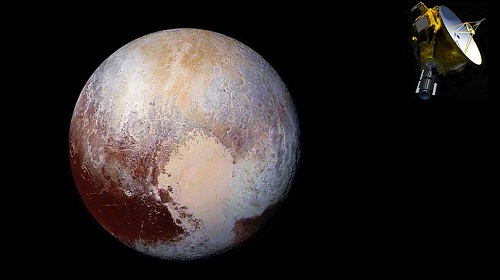On January 19, 2006 the “fastest spacecraft ever launched”[1] – the New Horizons space probe – lifted off from Cape Canaveral, Florida on a mission to Pluto. In February of 2007 it collected data from Jupiter as it flew by for a gravity assist catapult as it continued on to Pluto. On July 14th, 2015, New Horizons made its closest approach to Pluto. Scientists have now had an opportunity to review the initial data and pictures from New Horizons about the dwarf planet[2] Pluto, and many have been forced into a stunning but unavoidable admission: they’ve been wrong about Pluto for a long time.
What they found on Pluto was not at all what they were expecting to find. Scientists were expecting to find it heavily cratered, “a flat, dead world similar to our moon.”[3] Instead, what they actually found was:
- Icy Volcanoes
- The heart shaped area (right side partially faded) visible in the picture above named sputnik planum, of which scientists note “…this Texas sized basin of ice appears to be boiling.” [4] Planetary scientist Jani Radebaugh likens it to “a lava lake in slow motion”[5] made of nearly frozen Nitrogen cooled until the texture is that of tooth paste.
- Other areas feature a young looking surface, with no record of crater bombardment as expected. “These features are very, very young…Pluto is active today. That’s the headline.”[6] says Planetary scientist Dan Durda.
- An active geology driven by heat
- and “there’s pretty good circumstantial evidence that Pluto has a massive ocean in its interior”[7] says New Horizons mission principle investigator Alan Stern.
Secular Blindness
While scientists are willing to fess up to being wrong when confronted with objective data like that supplied to them from their own instruments aboard the New Horizons space probe, it is unlikely that they are willing to acknowledge error with regard to the below lessons, save the first, which they cannot deny without being accused of being science deniers. Continue Reading

